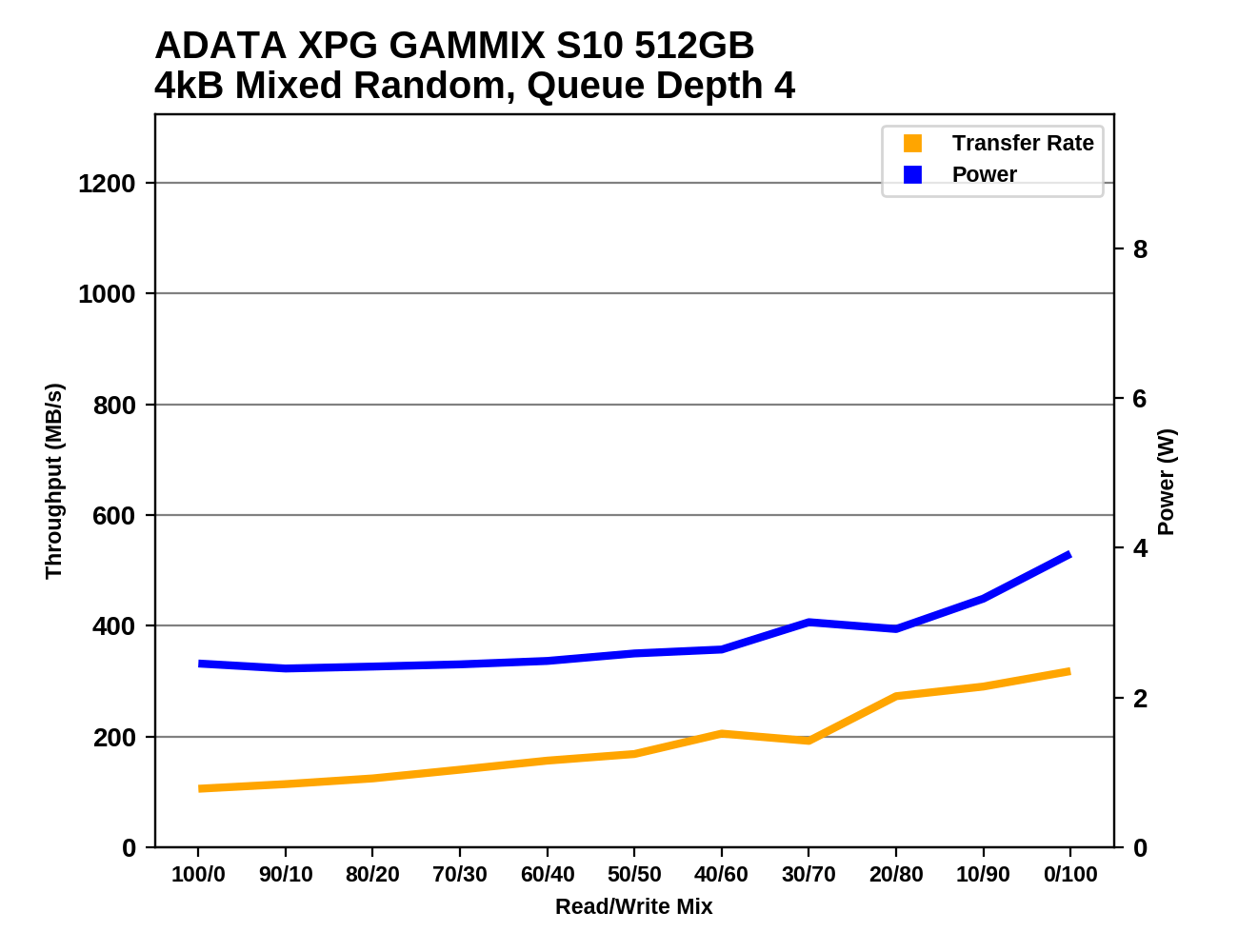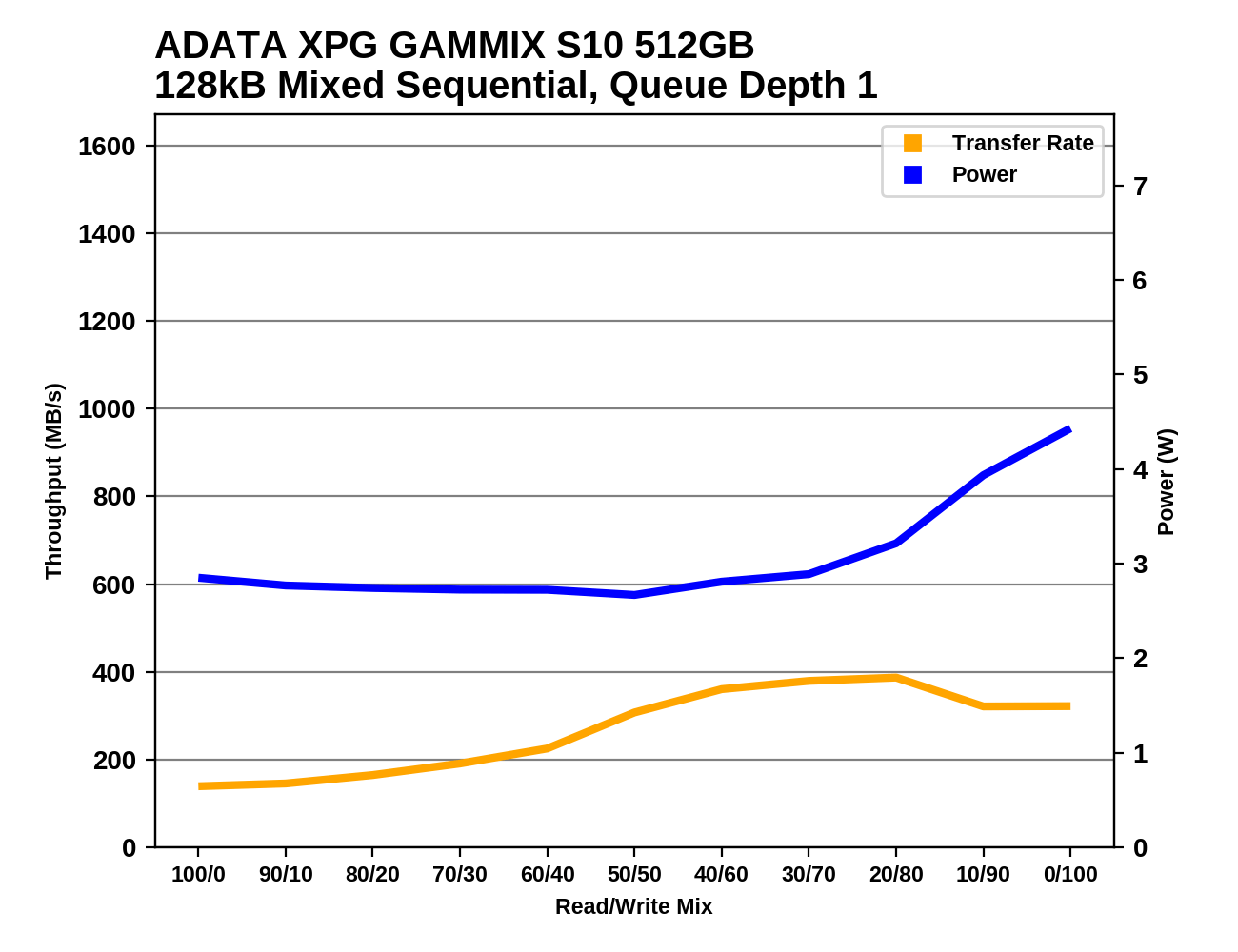The ADATA XPG GAMMIX S10 (512GB) SSD Review: Entry-Level NVMe With Style
by Billy Tallis on October 25, 2017 8:30 AM ESTMixed Random Performance
Our test of mixed random reads and writes covers mixes varying from pure reads to pure writes at 10% increments. Each mix is tested for up to 1 minute or 32GB of data transferred. The test is conducted with a queue depth of 4, and is limited to a 64GB span of the drive. In between each mix, the drive is given idle time of up to one minute so that the overall duty cycle is 50%.

The ADATA XPG GAMMIX S10 doesn't quite outperform every SATA SSD on the mixed random I/O test, but it comes close. The performance is respectable for a TLC-based SSD and is a substantial improvement over the Intel 600p.

The power efficiency of the GAMMIX S10 beats most of the TLC-based NVMe SSDs, but that is the least efficient product segment in general.
 |
|||||||||
The performance of the ADATA XPG GAMMIX S10 generally increases as the portion of writes in the random I/O workload grows, but the SLC cache does fill up and cause some trouble. The GAMMIX S10 is also unable to use its caching to deliver a much higher level of performance in the final phase of the test when the workload consists purely of random writes.
Mixed Sequential Performance
Our test of mixed sequential reads and writes differs from the mixed random I/O test by performing 128kB sequential accesses rather than 4kB accesses at random locations, and the sequential test is conducted at queue depth 1. The range of mixes tested is the same, and the timing and limits on data transfers are also the same as above.

The ADATA XPG GAMMIX S10 was near last place on both the sequential read and write tests, so it is no surprise to see it once again near the bottom of the chart on this mixed sequential I/O test. On average, a typical mainstream SATA SSD will offer better sequential I/O performance.

As with performance, the power efficiency of the GAMMIX S10 on the mixed sequential write test is second worst. The WD Black is significantly slower and less efficient, while the gap between the GAMMIX S10 and the Intel 600p is quite small.
 |
|||||||||
As with the random mixed I/O test, the mixed sequential I/O test fills the caches of the GAMMIX S10, leading to lower and less consistent performance toward the end of the test, after a first half showing modest performance increases.










27 Comments
View All Comments
futrtrubl - Wednesday, October 25, 2017 - link
Disappointing.jabber - Wednesday, October 25, 2017 - link
Why? You wouldn't notice if it could do 3500MBps either.futrtrubl - Thursday, October 26, 2017 - link
Because it does less but costs more. What isn't disappointing about that?jabber - Thursday, October 26, 2017 - link
Yeah but it looks much fancier so to the average Joe that's worth another $30! It's a strategy that Apple has used and been praised for for decades. Performance means nothing to the computing masses. It's just those of us on IT forums that care.FullmetalTitan - Thursday, October 26, 2017 - link
No "average Joe" is even looking at NVMe SSDs.This costs double the price of a GOOD SATA SSD, and frequently fails to even meet that performance level.
jabber - Thursday, October 26, 2017 - link
You'd be amazed at what I see 'Average Joe's buy. Shocking at times."Why did you buy...that?"
ddriver - Wednesday, October 25, 2017 - link
That's some pristine engineering idiocy right there, having the heatsink make contact with only a small part of the chip area deliberately.ddriver - Wednesday, October 25, 2017 - link
"GAMMIX" - more like "gimmix" LOLrrinker - Wednesday, October 25, 2017 - link
I saw that skipped right to the conclusion for the (predicted) disappointing results. If they screw up the engineering for the sake of appearance like that, I was sure the rest of it would be disappointing as well.ddriver - Wednesday, October 25, 2017 - link
The thing is that the heatsink is protruding between the adhesive pads, so it presumably makes contact with the chip, however without any thermal interface material it is likely that the heatsink severs to insulate and worsen thermal performance than to improve it.Probably it is a mix of both, yielding somewhere between barely improving to barely "detrimenting" thermal performance, making it mostly a pointless gimmick.
Like everyone else, ADATA is well aware how low average consumer IQ is, thus attempting to make this fly.
On the bright side of things, adding some thermal paste would easily make the cooling solution functional. Although I doubt the product performance will get any less pathetic because of that. They didn't put that heatsink there because it is throttling as a side-effect of being very fast. They put it as a cosmetic feature, that much is evident from the clumsy implementation.